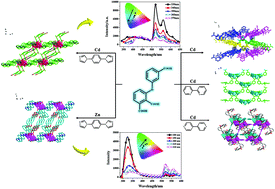Controllable synthesis of Zn/Cd(ii) coordination polymers: dual-emissive luminescent properties, and tailoring emission tendency under varying excitation energies†
Abstract
Based on a new asymmetric semi-rigid V-shaped tricarboxylate ligand 3-(2′,3′-dicarboxylphenoxy)benzoic acid (H3dpob), a series of zinc/cadmium(II) coordination polymers, {[Cd(Hdpob)(H2O)3]·H2O}n (1), [Cd(Hdpob)(bib)]n (2), [Zn(Hdpob)(bib)0.5]n (3), {[Cd1.5(dpob)(2,2′-bipy)]·0.5H2O}2n (4) and {[Cd3(dpob)2(4,4′-bipy)2]·3H2O}n (5) [bib = 1,4-bis(1-imidazolyl)benzene; 2,2′-bipy = 2,2′-bipyridine; 4,4′-bipy = 4,4′-bipyridine], have been successfully synthesized via hydro(solvo)thermal reactions. 1 forms a three dimensional (3D) supramolecular structure linked by two types of intermolecular hydrogen bonds based on zig-zag 1D chains, whereas 2 and 3 are obtained with a similar 2D layer structure by the same ligands and further connected into a 3D structure through hydrogen bonds. 4 displays a homochiral 2D structure though two achiral ligands 2,2′-bipy and H3dpob, which contains right-handed helical infinite chains. 5 is a 3D structure containing 2D metal-pyridine layer motifs, which are further pillared by beaded dpob3− ligands to complete the structure and form a 6-connected pcu (primitive cubic) net. In DMSO solvent, 1–5 illustrate dual-emission properties but have different low-energy emission (LE) intensities relatively. Extraordinarily, the difference resulting from central metals between 2 and 3 makes the intensity of LE dramatically enhanced and quenched. In this regard, the luminescence of 2 and 3 can be tuned between blue and green regions by varying the excitation light, and the tuning tendency can be tailored with inverse directions. Comparing their tunable-sensitivity to energy quantitatively, the theoretical calculation displays that 3 (4.29%) is little higher than 2 (3.59%) in a relative lower excitation wavelength zone. Meanwhile, five coordination polymers show distinct luminescence thermochromism in the solid state. When the temperature decreases from 298 K to 77 K, the red-shift from blue/green to the pure yellow light region is highlighted. The fantastic and unique luminescence phenomenon not only brings an insight into the synthesis of dual-emissive materials, but helps us to understand the luminescence behavior deeply as well.


 Please wait while we load your content...
Please wait while we load your content...